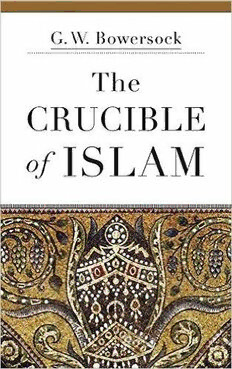
The Crucible of Islam PDF
Preview The Crucible of Islam
THE CRUCIBLE OF ISLAM THE C RU C I B L E I S L A M OF G. W. Bowersock Cambridge, Massachusetts, and London, England 2017 Copyright © 2017 by the President and Fellows of Harvard College all rights reserved Printed in the United States of America First printing Library of Congress Cataloging-in-Publication Data Names: Bowersock, G. W. (Glen Warren), 1936– author. Title: The crucible of Islam / G. W. Bowersock. Description: Cambridge, Massachusetts : Harvard University Press, 2017. | Includes bibliographical references and index. Identifiers: LCCN 2016046008 | ISBN 9780674057760 (alk. paper) Subjects: LCSH: Islam—History. | Arabs—History—To 622. | Islamic Empire—History—622–661. Classification: LCC BP50 .B69 2017 | DDC 297.09/021—dc23 LC record available at https://lccn .loc .gov /2016046008 Jacket art: Spandrel from the octagonal arcade, inner face of the east side, Dome of the Rock, courtesy of Said Nuseibeh Design: Jill Breitbarth CONTENTS Prologue 1 1 The Arabian Kingdom of Abraha 14 2 Arab Paganism in Late Antiquity 33 3 Late Antique Mecca 48 4 Ethiopia and Arabia 64 5 The Persians in Jerusalem 81 6 Muḥammad and Medina 101 7 Interregnum of the Four Caliphs 115 8 A New Dispensation 130 9 The Dome of the Rock 140 Notes 163 Select Bibliography 189 Acknowledgments 193 Index 197 Yathrib Najd Abd al-QaysFDx Khuzā‘aal-Ḥijāz Muzayna Hawāzin Kind a Tamīm MeQccuarayshal-(cid:28)‘āU’ikfāTẓhaqīfHudhayl Qaryat al-Fāw Kināna Azd al-Tabāla Ḥubāsha Kinda S Red Sea Tihuārāmha Najrān Kinda Farasān Murād m a w t Ṣan‘ā’ Ma’rib Ḥ a ḍ r a N Zula Qāni’ Axum Ẓafār ‘Aden In dian O cean SOUTHWEST ARABIA 0 100 300 km Map of Southwest Arabia, prepared by Fabrice Delrieux. FDx Ju dTahbūākm ‘Abs (R aalm-lN aĀflūidj) A sad Tamï Taymā’ m al-Rawwāfa al-Ḥijr / Madā’in Şaliḥ al-‘Ulā Ţay’ al al-Dahnā - JuhKahyaynbara YamāmaḤanīfa Fadak Ḥajr Yanbu‘ Suwā alYathrib / Medina Najd - Khuzā‘aḤijāz Muzayna Hawāzin Kinda JiMddeQacucaraayl-DMshahūjāz‘Ualk-a(cid:30)ālẓā-L’iāfJtiḥarThaqHīufdhayl Bi’r Murayghān Qaryat al-Fāw Kinā TaAbāla Kinda Red Sea na zd al-SurāhJurash Ḥubāsha N ḤIJĀZ Tihāma Najrān 0 100 km Map of the Ḥijāz, prepared by Fabrice Delrieux. THE CRUCIBLE OF ISLAM PROLOGUE The faith that drove the armies of Arabs out of the Arabian peninsula to take possession of Palestine, North Africa, and Syria within a few de cades in the first half of the seventh c entury remains t oday a power ful force in world affairs. What generated this force is as obscure now as it was in the beginning, and historians have been impeded by the tendentious character of most of the sources for this g reat up- heaval, as well as by their own prejudices. It is difficult for non- Muslims, above all Jews and Christians, to be dispassionate in confronting the tide of Muslim conquests that swept over the ancient cultures of the Near East. It is no less difficult for Muslims to apply scholarly rigor to the word of God as well as to a historiographical tradition that significantly post- dates the events it rec ords. Yet in view of the im mense authority of Islam in the modern world it becomes more imperative than ever for both sides to make the effort. 1 THE CRUCIBLE OF ISLAM The pioneering generation of Islamicists in the West, including Theodor Nöldeke, Julius Wellhausen, and Ignaz Goldziher, applied the methods of classical philology as they had been successfully imported into the study of the New Testament and the Hebrew Bible by Erasmus and Gesenius. As these scholars recog- nized, the transmission of t hese old texts was sus- ceptible to critical analy sis, which in the fullness of time could be supplemented by surviving documents on stone, papyri, and coins, and eventually the dis- coveries of archaeological excavation. For Islam the authority of the Qur’ān, being the revealed word of God, notoriously resisted the Erasmian challenge, because of the vast hiatus between its creation, at what ever time and by what ever means, and very much later reports of the context from which it came. It took nearly two centuries for Islamic exegetes to acquire a corpus of what was known about the gen- esis of their religion. By then a complex pro cess of textual contamination was already in place. During those two centuries non- Muslim chroniclers, inter- preters, and historians had been at work in a variety of languages—G reek, Latin, Armenian, Syriac, and Ar- abic above all. They had conspicuously exploited one another’s material, which left traces of their bor- 2 PROLOgUE rowing in the texts they wrote, but naturally they had their own doctrinal perspectives. Three recent books illustrate the dilemma facing anyone looking into the crucible in which Islam was forged.1 Although there is little doubt that this cru- cible lay in the northwestern Arabian peninsula, con- tacts between that region and the surrounding cultures of Palestine, Himyar, Ethiopia, and Persia i nevitably contributed to a potentially explosive mixture. So did indigenous traditions of polytheism that had been there all along, as well as a more recent evolu- tion of Jewish and Christian communities that was replete with hostility and massacre. The three new books attempt to examine the rise of Islam in very dif fer ent ways. Yet they all traverse the familiar path that starts the rise of Islam with Muḥammad’s birth at Mecca about 570 and the revelations he received from Gabriel, and they then pro gress to his subse- quent emigration (hijra) to Medina in 622. They all continue with a series of traditional dates, battles, and conquests. All three books rec ord Muḥammad’s canonical death in 632 and go on to examine the tur- bulent reigns of the four so- called orthodox caliphs who succeeded him before the establishment of the Umayyad dynasty in Damascus about 661.2 By their 3
